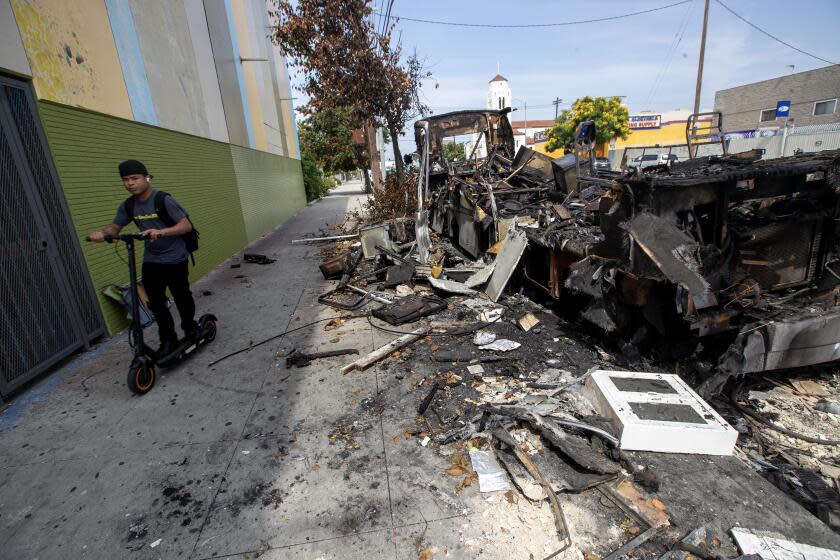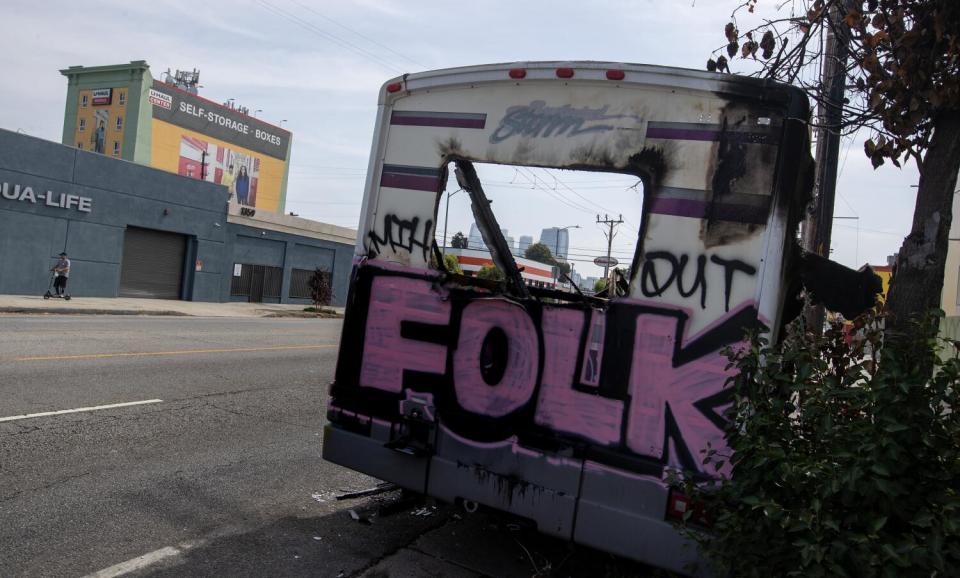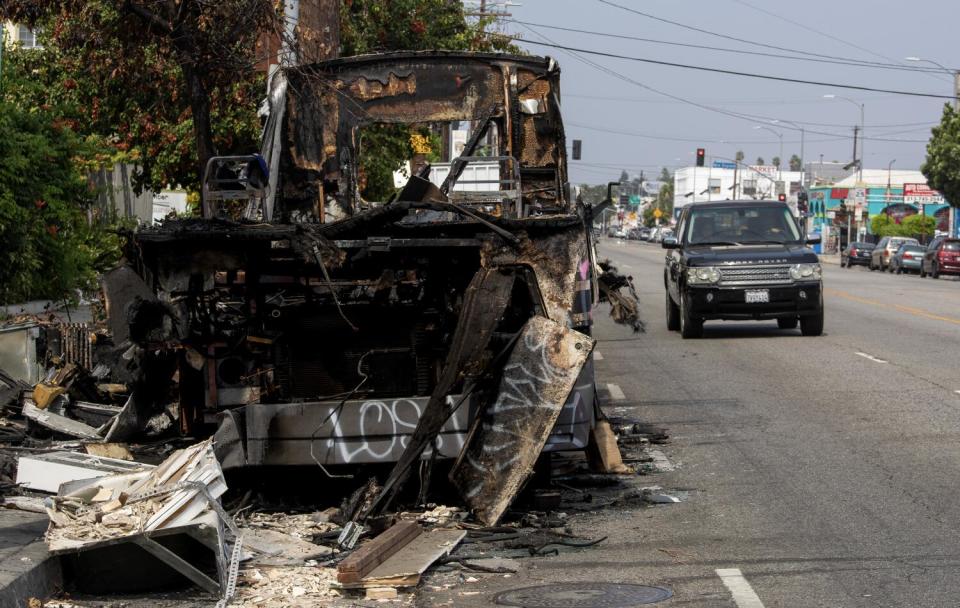Column: Someone torched an RV. Why did it take LA so long to tow it?

When I think of Washington Boulevard, I think of one of L.A.’s unsung thoroughfares.
I think of a 27-mile road that starts near the Pacific Ocean in Venice, hugs Culver City's northern border, runs parallel to the 10 Freeway through Black and Latino neighborhoods in Los Angeles before passing by Commerce, Montebello and Pico Rivera and finally petering out in Whittier.
I think of mom-and-pop shops and newer stores. Gentrifying neighborhoods and working class ones.
I don’t think of a burned out RV next to kid-focused nonprofits. Yet that’s what I found recently outside the Magnolia Place Family Center in Pico Union.
It was a Tuesday afternoon. I was late for an interview and thus barreling down the 1300 block of West Washington. But the sight of a massive, burned out vehicle on a busy street immediately made me do my best "Fast & Furious" imitation, pulling what was probably an illegal U-turn to inspect the scene.
The only parts of the RV that remained somewhat intact were the base, the tires and the frame around the rear window. Half of the branches of a nearby tree had charred. Backpacks, chairs and plywood inside the RV's outline were reduced to ashes. Wires and springs were strewn everywhere.
A man dug through what remained. He wouldn’t give me his name but claimed the fire happened two weeks earlier, when vandals targeted his friend, who lived in the RV and got out just in time.
Read more: Column: The real and complicated reasons why Los Angeles still has so many RV encampments
I had to get to my assignment but told myself I would stop by again that Saturday, since I had to drop off food to a friend who lived off nearby San Vicente Boulevard. Surely, I reasoned, the city by then would’ve towed this hazardous eyesore from this stretch of Washington, where cars speed by at all hours and families walk by?
The RV was still there four days later, on Saturday — and a bathtub now lay on the sidewalk next to it.
Joel Medrano and Ricardo Amaya were getting ready to repair a section of Magnolia Place's wall that had sustained damage during the fire. Every time they scraped off a blackened layer of paint, a noxious stench filled the air.
“Was it two weeks ago when there was the fire?” Medrano asked Amaya in Spanish. Amaya shrugged. “I think it was three weeks,” he said. “However long, it’s too long.”
Across the street, an employee at an air conditioner shop told me that not only had it been three weeks since the RV burned down, but the bright graffiti on one of the few standing sections of the vehicle’s shell was tagged after the fire.
“The police pass by, but they never stop to investigate,” said the employee, who declined to give his name because he wasn’t authorized to speak. “I was wondering who to call — City Hall? Fire? Does it matter? Will anyone even do anything?”

On Monday, I talked to Magnolia Place facility manager Roland Salvador. He asked the fire crew that put out the blaze when the abandoned heap would be removed. He asked the same question to city workers who came a few days later, when someone set fire to what was left. He asked the parking enforcement officer with the Department of Transportation who regularly tickets illegally parked cars on Washington.
“And the answer I keep hearing is that, ‘Oh, this has been reported.'
“Gustavo,” he continued. “Do you have any idea of any person, department or agency that can help me?"
RV encampments grew rapidly across L.A. during the pandemic, partly because of the city’s ever-increasing cost of living but also because the Department of Transportation announced a moratorium on towing inhabited RVs in the beginning of 2021. The encampments have hung on despite the rescinding of the moratorium last year and assurances by Mayor Karen Bass this spring to my colleague Erika D. Smith that the issue would “absolutely” be dealt with “because it's a very serious issue.”
Despite the protestations of nearby residents, it's difficult, if not nigh impossible, to remove vehicles with people living inside, even if they're violating parking and sanitation laws. Those occupants have legal protections, after all. But there are those types of RVs, and then there’s the mess on West Washington Boulevard that looks like a set prop from a Marvel movie battle scene.
Is it really that hard for L.A. to tow a torched RV?
Read more: Los Angeles lifts moratorium on towing RVs, pledges to move problem campers
L.A. Fire Department public information officer Erik B. Scott told me his department investigates all vehicle fires and calls in the arson unit if it suspects anything suspicious. The department then calls the LAPD to facilitate towing, but Scott had no idea what a typical turnaround time is, since "we are rarely involved through the entire process."
LAPD Community Safety Partnership Bureau Capt. Ryan Whiteman said officers are allowed to tow a vehicle if it's stolen, blocking a roadway or an entrance to a building, used in a crime or “constitutes an imminent threat to public safety or property.” But one big roadblock they're facing: not enough space to store impounded RVs, which Whiteman said "is being worked on within the city family of agencies."
He added that the RV next to Magnolia Place was referred to the Department of Transportation “for follow up and removal,” since that agency has the “primary response” for towing vehicles in L.A.
DOT spokesperson Colin Sweeney's initial response to my list of questions Monday was to ask for the location of the RV, since “it has happened before that reporters ask us about issues located outside of city limits.”
When I sent him the address proving that the RV was within city limits, he emailed a statement a day later confirming that the vehicle was “subject to impound" but noting that the DOT had to work with the Department of Sanitation "to ensure hazardous materials are removed before the vehicle is towed."
Nevertheless, Sweeney concluded, the RV in question was “expected to be removed this week.”

He didn’t respond when I asked if three weeks was how long it usually took. With a game of municipal kick-the-can like this one, imagine how the Department of Transportation treats regular folks!
Salvador did have some sympathy about the city’s delayed response when we talked: “I know this is not the only area where this is happening. But this is really very awful. If it was on my property, I can immediately take action.”
He has worked at Magnolia Place for 20 years and said the only time there was a problem like this was during the pandemic, when unhoused people put up tents on a corner near the nonprofit's parking lot. The tents disappeared after someone set them on fire.
The city cleaned up that mess right away. "This RV, I don't know how come they cannot clean it," he said.
I drove back to Magnolia Place on Thursday afternoon. The RV was finally gone. But the clean-up job was weak salsa, at best. And around the corner, on a side street, was a hollowed-out RV I hadn't noticed before.
L.A.'s game of Wrecked RV Whac-a-Mole continues.
This story originally appeared in Los Angeles Times.

